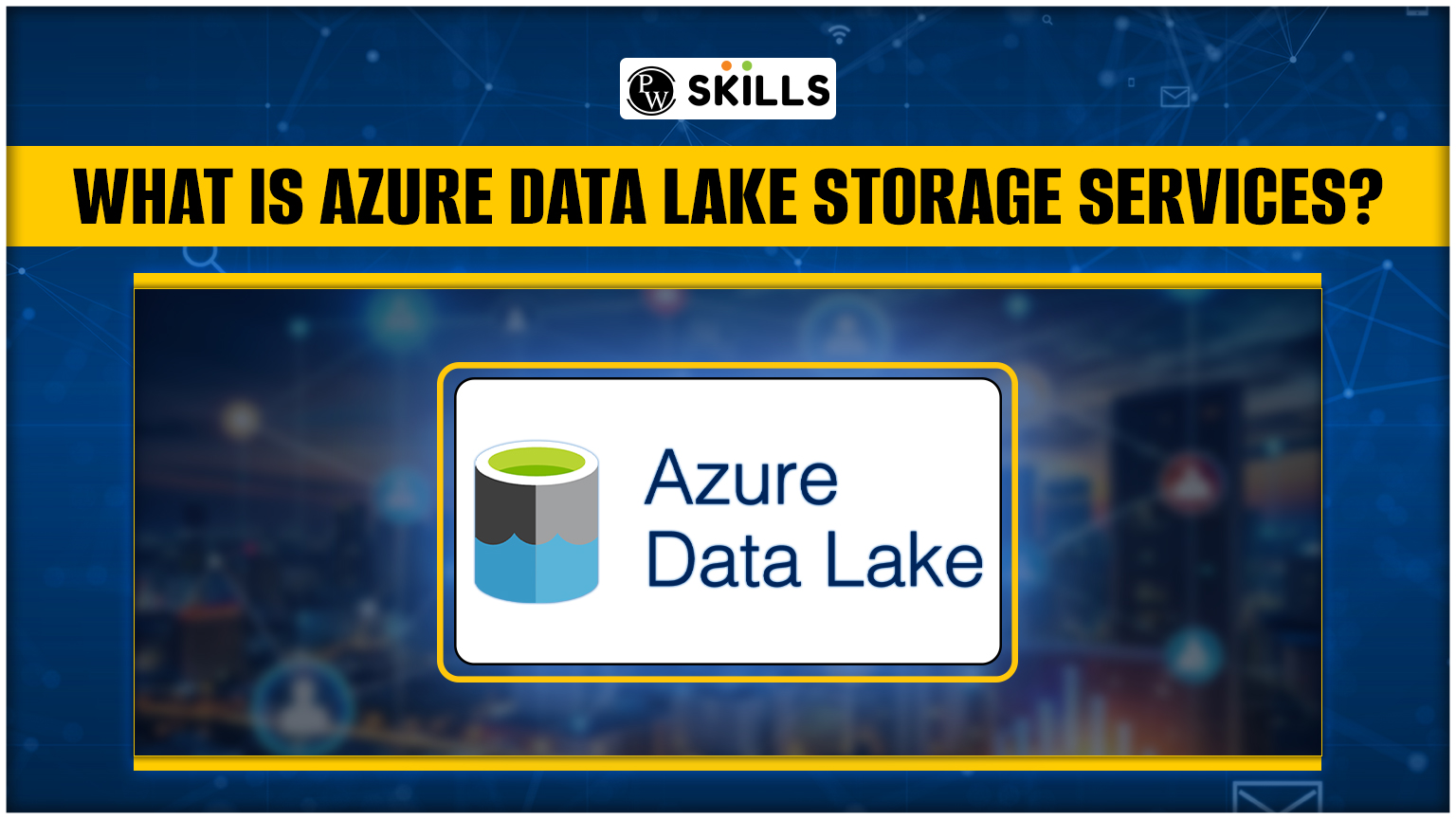Nowadays, with the rapid expansion of digital technologies, many data sources are producing large amounts of data every second. We no longer get data from simple computer systems. Today we get data from everywhere, such as sensors, IoT devices, transactions, smartphones, social media, appliances, etc.
Big firms use these data to extract market trends, patterns and customer behaviour to help them make informative decisions. To store and process this massive amount of data we need to have sophisticated technology which offers storage with reliability and scalability. The need for efficiently storing such a large amount of data is further increased by the abundance of data coming from diverse sources.
Data Lakes are large raw storage services, usually for unstructured data from various sources. Azure data lake storage services provide limitless storage capacity with data processing and analytics workloads. It also provides effective security using advanced integration and logs. In this article, we will take you through the deeper concepts of Azure data lake storage.
Key Takeaway
- Azure Data Lake storage offers various services to help developers, data scientists, and data analysts store large amounts of data, regardless of dimension.
- Azure Data Lake storage is provided by Microsoft Azure and is used to store massive amounts of data and perform analytics and data processing workloads.
- Azure Data Lake Storage Gen2 is the latest version of cloud-based big data storage by Microsoft Azure.
- Azure data storage provides Role Based Access control (RBAC) with Azure Active Directory (AAD) integration.
- It provides Hierarchical File System (HFS) Support for better data management with blob tiers (Hot, Cool and Archive) options.
What is Data Lakes?
A Data Lake is a storage repository that stores, processes and secure a large amount of data from various sources. Data Lakes stores data in a raw and unstructured format. Hence, there is no validation, transformation or preprocessing of the data. It supports massive parallel operations with data ingestion from various sources. Data Lakes consists of many advanced analytic tools.
Data Lake Vs Data Warehouse
Data Lake and Warehouse are often confused for the same and used together. However, they share some significant differences, which must be within our knowledge. Check the table given here to analyze the difference.
| Data Lake | Data Warehouse |
| Data stored in the data lake is raw and unprocessed. | The data warehouse stores processed data. |
| It offers an undefined reason for storage. | It offers a pre-defined reason for storage. |
| It is often used for data science analysis. | It is used for business analysis. |
| Data lakes handle both unstructured and structured data. | Data warehouses store structured, processed data. |
| They are often used for advanced analytics and machine learning. | A Data Warehouse is a better option for reporting and historical analysis. |
If you are looking for a little more flexibility, then you can choose a new architectural paradigm known as Data Lakehouse. It provides the best of the two data lakes and data warehouses. It supports data stored in raw format in structured schemas like data warehouses.
What is Azure Data Lake Storage?
Azure Data Lake Storage is a PaaS solution service platform provided by Microsoft Azure. It supports trillions of files, up to petabytes in size and advanced big data analytics on its cloud platform. It provides unlimited storage support for any type of structured, semi-structured, or unstructured data.
Azure cloud platform is part of a broader Azure storage ecosystem, suitable for big data analytics, machine learning and data warehousing. It provides access control using Hadoop Distributed File System (HDFS) and integrates seamlessly with various services and tools offered on Azure.
What is New Azure Data Lake Storage Gen2?
Azure Data Lake Storage Gen2 is the latest cloud-based repository provided by Microsoft Azure. It supports both unstructured and structured data. It allows you to easily manage a massive amounts of data with features like file system semantics, scalability, disaster recovery capabilities, tiered storage, high availability, etc.

Data Lake Gen2 provides Hadoop Compatible access with hierarchical directory structure. It provides finer grain security model with massive scalability. It is priced at Azure Blob Storage levels such as object level tiering and automated lifecycle policy management to manage big data storage costs. There are additional security features in Gen2 like you can set preferences at file level or directory level.
Three Major Components of Azure Data Lake Storage
Azure Data Lake consists of three major components, which constitute the major services available on Azure Data Lake.
1. Azure Data Lake Storage
Azure Data Lake Storage (ADLS) offers unlimited storage of unstructured or structured data from various sources. It offers high scalability and security for higher analytics processes. ADLS can easily integrate with other platforms, providing seamless data storage for organizations.
It offers role-based access control through the Azure Active Directory (used for identity management). Users can manage their data and access it using Hadoop Distributed File System (HDFS). If your tool supports HDFS, then you can easily integrate Azure Data Lake storage.
2. Azure Data Lake Analytics
Azure Data Lake Analytics is specially designed to indulge in various types of data analytics and processing services with big data and machine learning workloads. It provides integrated analytics using big data and data warehousing capabilities. Users can easily process programs using Python, R, SQL, and .NET over large amounts of data.
Azure data analytics also supports a range of frameworks, including Hadoop, Spark, Hive, Hbase, etc. This is a pay-per-use model where users pay for on-demand analytics over the data. It provides a cost-effective solution for data analytics and processing, as you only need to pay for the services you use.
3. Azure HDInsights
Azure HDInsights is an open-source analytics platform that helps organizations manage big data storage and analysis. It is supported with Cloud Hadoop and provides optimized components for Apache Hadoop, Spark, Hive, and MapReduce to provide a range of options for users to process massive amounts of data. There are many tools and frameworks that users can integrate with this cloud tool component.
Who Can Benefit from Azure Data Lake Storage?
Azure data lake storage is proficient for businesses or organizations looking to manage big and complex data. Organizations which use massive amounts of data in their daily operations require this effective storage service.
- Azure Data Lake Storage can be beneficial for data scientists, developers, and analysts in the team to store and easily carry out analysis on data of any size.
- Azure data storage services can easily integrate with other cloud environments.
- It offers debugging and parallel program support for data processing in different languages (Python, R, U-SQL, etc).
- It provides faster deployment, there is no need to download any additional elements to go live.
- It provides a higher level of security with advanced encryption, Azure Active Directory for identity management and Role Based Access Controls to safeguard data from unauthorized access.
- Azure Data Lake services provide hybrid cloud environments using Azure HDInsights.
- It is cost effective as it works on a pay-per-use basis, where you will only need to pay for the services you use.
Azure data lake storage services are beneficial for organizations that require data warehousing, IoT capabilities, hybrid cloud environment support faster deployment, parallel processing and higher security and reliability in the cloud environment.
Features of Azure Data Lake Storage

Azure data services are used by organizations working on advanced big data analytics and utilizing large amounts of data on a daily basis. It supports data processing and analytics on unstructured or structured data from various platforms using various programming languages. Some of the benefits of Azure data lake storage are mentioned below.
1. Effective Data Management
Azure Data Lake manages different data types and stores a large amount of data on a single platform. It provides efficient data storage, accessibility, and security for large amounts of data. ADLS Gen2 provides file-level organization through ADLS Gen2 to manage the structuring of data with optimized performance.
2. Scalability and Performance
Azure Data Lake Storage can handle large amounts of data, supporting big data analytics and storage. It integrates various Azure frameworks and tools to provide real-time analytics and large-scale data processing.
3. Advanced Security and Compliance
ADLS offers effective data governance compliance with advanced auditing and encryption It easily integrates with Azure Active Directory (AAD) for identity verification and access management. using Role-Based Access Control (RBAC).
4. Effective Integration and Analytics
Azure Data Lake Storage provides easy integration with other cloud platforms and a variety of data services, such as Azure Synapse Analytics, Azure HDInsights, Azure Data Factory, etc., for seamless data processing and analytics.
5. Low Cost Storage
Azure Data Lake consists of a pay-per-use service where users need to pay for the services they use. You can store an unlimited amount of data from various sources with various functionalities, such as advanced data analytics, life cycle management systems, data migration, etc.
How to Get Started with Azure Data Lake Storage?
Getting started with Azure Data Lake storage is easy with most of the tools hence, there is no need to specifically download locally on the system.
- First, visit the Azure portal at azure.microsoft.com or you can also download their mobile application.
- Create an Azure Data Lake account if you do not already have one. You can use your Microsoft account or GitHub to sign in.
- Get a free trial now if you do not have a premium subscription. The trial generally lasts for 30 days.
- You will not need to install anything on your personal computer. Every service and tool is available on the cloud, which you can directly access from the portal.
Effective Practices When Starting with Azure Data Lake
While managing big and complex data comes with many challenges on Azure. However, if we implement Azure storage in the best way we can unlock its full potential.
- Manage Access and Security: Azure Lake data storage provides Role Based Access Control (RBAC) integrated with Azure Active Directory to offer you high security and reliability. However, share access to the platform wisely.
- Maintain Data Consistency: Keep your data well organized in folders with catchy names to provide easier access. It is important to properly plan your directory layout. For instance, you might consider the given layout below.
{Region}/{SubjectMatter(s)/In/{yyyy}/{dd}/{hh}/
- Utilize Documentation: The documentation provides guidance for using the functionalities of tools and frameworks on Azure, especially when you are a beginner.
- Consider Premium: If your workload is high and possess strict deadlines then using a premium Azure data lake account will bring many benefits to you. However, if you are still learning and your workload is low then you can use a free trial account.
- Use Azure Tools: There are many different ways of ingesting data into Azure Data Lake Storage coming from different sources. It is important to use advanced tools to help you ingest, analyze and visualize data.
Challenges of Azure Data Lake Storage
Despite some major advancements in the storage system, it faces some challenges, which are mentioned below.
- Managing huge and complex data to keep consistent quality, security and reliability controls in our hands offers a challenging task for the team.
- Must have a profound skill set in big data and analytics with the relevant tools and frameworks. You might need to upskill yourself to make the most of this online cloud platform.
- Finding the data you need from such big data storage can become a tedious task, let alone managing them comes first.
- The cloud platforms that do not support Hadoop Distributed File System (HDFS) cannot easily integrate Azure Data Lake. Integrating Azure Data Lakes can be complex. Organizations often work on custom solutions to leverage other third-party tools.
Azure Data Lake Storage: Tools and Uses
There are many tools available on the Azure portal that can help you ingest data coming from various sources and implement analysis and visualization of that data.
| Processes | Azure Tools |
| Ingest data from various sources(Relational data, ad hoc data, HDInsights, server logs, large data sets) |
|
| Processing and Analyzing data | Azure Synapse Analytics, Azure HDInsights, Databricks |
| Visualization | Power BI, Azure Data Lake Storage Query acceleration |
| Downloading data | Azure Portal, Power Shell, Azure CLI, Azure SDKs, Apache DistCp |
Learn DevOps and Cloud Computing with PW Skills
Enrol in PW Skills online DevOps and Cloud Computing Course and learn cloud computing, AWS fundamentals, database services, software version control, deployment and work on real world projects.
The course is specially prepared for beginners who are looking for a bright career in DevOps and Cloud Computing. Become job-ready and explore numerous opportunities only at pwskills.com
Azure Data Lake Storage FAQs
Q1. What is Azure Data Lake Storage?
Ans: Azure data lake storage is a cloud-based data lake solution provided by Microsoft Azure. It provides a massive amount of data storage and facilitates data analytics workloads.
Q2. Who uses Azure data lake storage services?
Ans: Azure data lake services are used by organizations working on big and complex data tasks daily. It is helpful for data scientists, developers and analysts to store large amounts of data and carry out all types of data types and processing.
Q3. Why use Azure Data Lake Storage?
Ans: Azure data lake storage provides scalable storage with data processing, Machine learning, text mining, SQL queries, and analytics workloads.






